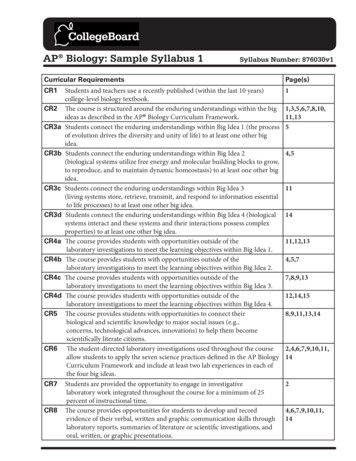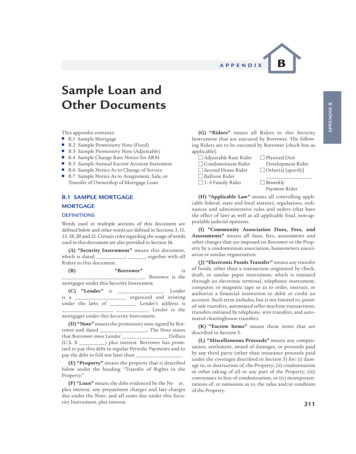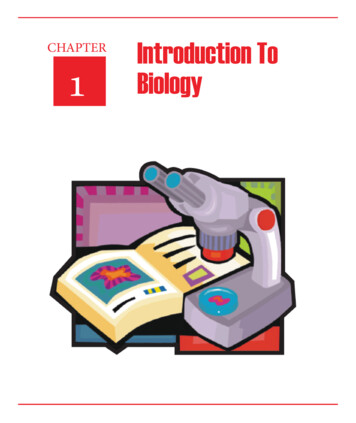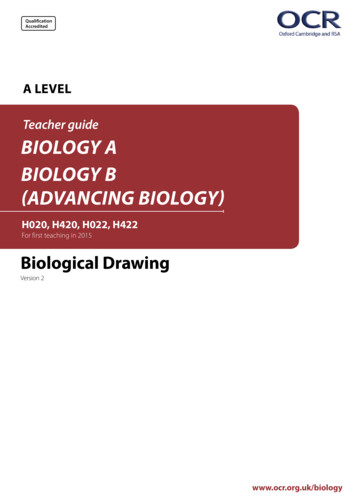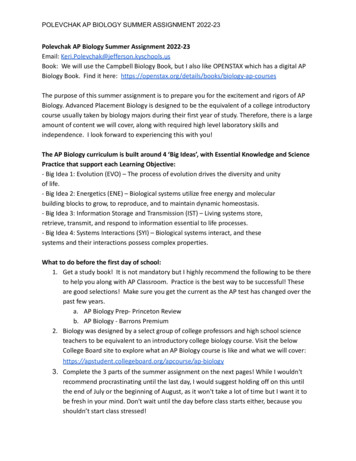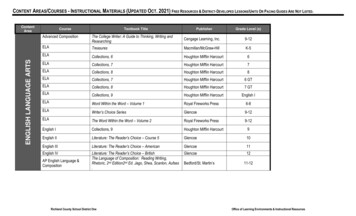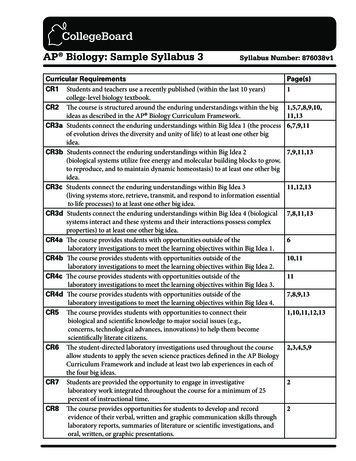
Transcription
AP Biology: Sample Syllabus 3Syllabus Number: 876038v1Curricular RequirementsCR1 Students and teachers use a recently published (within the last 10 years)college-level biology textbook.CR2 The course is structured around the enduring understandings within the bigideas as described in the AP Biology Curriculum Framework.CR3a Students connect the enduring understandings within Big Idea 1 (the processof evolution drives the diversity and unity of life) to at least one other bigidea.CR3b Students connect the enduring understandings within Big Idea 2(biological systems utilize free energy and molecular building blocks to grow,to reproduce, and to maintain dynamic homeostasis) to at least one other bigidea.CR3c Students connect the enduring understandings within Big Idea 3(living systems store, retrieve, transmit, and respond to information essentialto life processes) to at least one other big idea.CR3d Students connect the enduring understandings within Big Idea 4 (biologicalsystems interact and these systems and their interactions possess complexproperties) to at least one other big idea.CR4a The course provides students with opportunities outside of thelaboratory investigations to meet the learning objectives within Big Idea 1.CR4b The course provides students with opportunities outside of thelaboratory investigations to meet the learning objectives within Big Idea 2.CR4c The course provides students with opportunities outside of thelaboratory investigations to meet the learning objectives within Big Idea 3.CR4d The course provides students with opportunities outside of thelaboratory investigations to meet the learning objectives within Big Idea 4.CR5 The course provides students with opportunities to connect theirbiological and scientific knowledge to major social issues (e.g.,concerns, technological advances, innovations) to help them becomescientifically literate citizens.CR6 The student-directed laboratory investigations used throughout the courseallow students to apply the seven science practices defined in the AP BiologyCurriculum Framework and include at least two lab experiences in each ofthe four big ideas.CR7 Students are provided the opportunity to engage in investigativelaboratory work integrated throughout the course for a minimum of 25percent of instructional time.CR8 The course provides opportunities for students to develop and recordevidence of their verbal, written and graphic communication skills throughlaboratory reports, summaries of literature or scientific investigations, andoral, written, or graphic ,132,3,4,5,922
Course OverviewAP Biology: Sample Syllabus 3The course is designed around the AP Biology Curriculum Framework thatfocuses on the major concepts in biology and their connections. Additionally, theCurriculum Framework provides a basis for students to develop a deep conceptualunderstanding as well as opportunities to integrate biological knowledge and thescience practices through inquiry-based activities and laboratory investigationswithout having to teach a textbook from cover to cover.Textbooks/ResourcesRaven, Johnson, Mason, Losos, and Singer, BIOLOGY, 9th Edition (2011). [CR1]Each student has access to the investigations contained in AP BiologyInvestigative Labs: an Inquiry Based Approach, as well as other laboratoryinvestigations as deemed necessary.Teaching StrategiesAP Biology is structured around four Big ideas (Evolution, Energy Processes,Information, and Interactions) described in the Curriculum Framework, whichencompass the core scientific principles, theories, and processes governing livingorganisms and biological systems. At least one of the Big ideas will be incorporatedin every lesson throughout the course. [CR2] Because evolution is the foundationupon which the entire course is based, it will be referenced throughout the entirecourse, and science as a process will be woven throughout both the investigationsand the class activities outside of the investigations.Students begin each unit with a list of enduring understandings and big ideas toguide them throughout the main points of the unit and to frame students’ classnotes. Students are encouraged to add to these notes during class discussions,listing all of their questions that arise as the class discusses each topic. Classdiscussions may be based on animations from various sources (textbook, CDs,Internet, etc.) to help the students visualize what they have read. Quizzes areinterspersed throughout the unit and inform how instruction may need to beadjusted to improve student learning.To help students apply biological, scientific knowledge and critical thinking skillsto major issues of social concern, they will read and report on (both orally andwritten) one novel that includes biology content in the story-line. For the novel,students must explain the science and science processes in the book, as well asdescribe the accuracy of their use and presentation in the book. In addition,students will need to be prepared to engage in monthly current event discussionsinformed by readings from recent scientific journals. Through these activities,students are given the opportunity to see that biology is in their everyday lives andis not just a chapter in a textbook. [CR5]CR1: Students andteachers use arecently published(within the last 10years) college-levelbiology textbook.CR2: The course isstructured aroundthe enduringunderstandingswithin the big ideasas described in theAP BiologyCurriculumFramework.CR5: The courseprovides studentswith opportunitiesto connect theirbiological andscientific knowledgeto major socialissues (e.g.,concerns, technological advances,innovations) to helpthem becomescientifically literatecitizens.1
Investigative ComponentAP Biology: Sample Syllabus 3Laboratory investigations make up a minimum of 25% of instructional time.[CR7] Students will conduct a minimum of eight inquiry-based investigations(two per Big idea). [CR6] Supplemental labs and activities are also used to widenthe range of topics covered in a hands-on, discovery mode. By undertaking avariety of investigations throughout the course, all seven science practice skillswill be used by students on a regular basis with a goal of leading students towardopen inquiry investigations. The science practice skills need to be honed over theentire course and reinforced through opportunities to make observations, askquestions based on those observations, and investigate their own questions bothin and out of the designated lab times. It is critical for me, as an instructor, to helpstudents discover how the biological world works as we know it--and to learn howto investigate the biological world that is still unknown. That is why theinvestigations are a key to this entire course.Students will maintain a written record (lab notebook) of investigationsconducted. In addition, they will be asked for the following throughout the course:[CR8]Ø Formal lab report that emphasizes the development and testing of ahypothesis, the ability to organize collected data, and the ability to analyzeand clearly discuss the results.Ø Poster presentations (create poster with main investigation components;present to small groups or whole class; field questions).Ø Self-assessments of their ability to work in group investigations that willoften be conducted in teams of 2 or 3 in order for students to developgroup skills and learn the importance of collaboration among scientists.Course ScheduleThe following table describes how the enduring understandings/essentialknowledge statements, learning objectives and seven science practices are thefocus of each unit within the course. Due to the reduction in required content forAP Biology, all sections of each chapter will not be covered and/or may be used forreference as needed. The outlined timeline is approximate. Assignments includemany ways to meet the objectives (worksheets, readings, dry labs, wet labs, FreeResponse writing, projects, etc.), and a few of these activities have been elaboratedupon in order to fully demonstrate the incorporation of curricular requirements.These assignments connect biological content across big ideas.CR7: Students areprovided theopportunity toengage in investigative laboratorywork integratedthroughout thecourse for aminimum of 25percent ofinstructional time.CR6: The student-directed laboratory investigationsused throughout thecourse allowstudents to applythe seven sciencepractices defined inthe AP BiologyCurriculum Framework and include atleast two labexperiences in eachof the four big ideas.CR8: The courseprovides opportunities for students todevelop and recordevidence of theirverbal, written andgraphic communication skills throughlaboratory reports,summaries ofliterature orscientificinvestigations, andoral, written, orgraphicpresentations.2
xxxxxxxBig Idea 4: InteractionsxBig Idea 3: InformationxBig Idea 2: Energy Processes5. perform data analysis & evaluation of evidencexBig Idea 1:Evolution4. plan & implement data collection strategiesx7. connect & relate knowledge3. engage in scientific questioning2. use mathematics1. use representations and modelsUNITS and ACTIVITIESBig Ideas/Science PracticesMatrix6. work with scientific explanations/theoriesAP Biology: Sample Syllabus 3Unit 1: INTRODUCTION/NATURE OF SCIENCESafety LectureNature of Science: checks activityxScience as a Process: intro to LabQuestLab [CR6]Nature of Science: design experiment Lab[CR6]xxxScience as a Process: measurement Lab[CR6]Chemistry of Life Activity or Lab [CR6]xxxxxOrganic Nomenclature WorksheetActivity of Enzyme Lab [CR6]xxEnzyme Catalysis ModelsxToothpickase and/or Paperase ActivityxxEnzyme Optimization ActivityxxxxxxxxxxxxxxxxxxxxxxxUnit 2: EVOLUTIONARY BIOLOGY & BIODIVERSITYHardy-Weinberg Lab (Transitioned) [CR6]xxEvolutionary Agents ActivityxxGenetic Drift w/ Random Numbers ActivityxxxxInterpretation of Fossils ActivityxxxxDichotomous Key ActivityxxCladograms ActivityxxxxxxxArchaelogical Interpretation ActivityxxxxxxxGeologic Time Activityxxxxxxxxxxx3
AP Biology: Sample Syllabus 3BLAST Lab, part 1 [CR6]xxxxxxxxBacterial Transformation Lab [CR6]xxxxxxxxxxxxxxxxxArtificial Selection Lab [CR6]Origin of Life ActivityxxxUnit 3: ECOLOGY/BEHAVIORFruit Fly Behavior Lab [CR6]xxxxxxxAquatic Primary ProductivityxxxxxxxEcology: survivorship curvesxxxxxxBehavior: Competition/Cooperation LabxxxxxA Lesson in ConditioningxxxxxTrial and Error Learningxxxxx[CR6]xxxxxxUnit 4: INTRODUCTION TO HOMEOSTASIS & RESPONSE TO THE ENVIRONMENTDiffusion and Osmosis Lab [CR6]xxxxMicroscopyxxxxxxxxxxExploring Rate of Diffusion ActivityUNIT 5: CELL PROCESSES/CONNECTIONS: RESPIRATION & ANIMAL HOMEOSTASISCellular Respiration Lab [CR6]xxxxxxxxxExercise and Pulse RatexxxxxxxxxThe Kidney and HomeostasisxxxxxxxAntibody DiversityxxxxxxxUnit 6: CELL PROCESSES/CONNECTIONS: PHOTOSYNTHESIS & PLANT HOMEOSTASISPhotosynthesis Lab [CR6]xxTropismsxWater Movement in Plants ActivityxxTranspiration Lab [CR6]xxxxxxxxxxxxxxxxxxxxxxxxxxxxxxxxxUnit 7: MAKING NEW CELLS & ORGANISMSCell Division Lab [CR6]xxGenetics of Organisms Lab [CR6]xGenetics ActivityxBLAST Lab (open inquiry) [CR6]xxxxxxChi Square Problem practice problemsGenetics Practice problemsxxxxxxxxxx4
AP Biology: Sample Syllabus 3Unit 8: ALL ABOUT PROTEINSBiotechnology Lab I: BacterialTransformation [CR6]xxxxxxxBiotechnology Lab II: Restriction EnzymeAnalysis of DNA [CR6]xxxxxxxxProtein Synthesis ActivityxxxxxMolecular Evolution in a Test Tube ActivityxxxxxxxxxSequencing and Paper Plasmid ActivitiesSam Rhine Genetics Update ConferenceBig ideas and enduring understandings as well as science practice skills; thus allassignments will help students meet the learning objectives identified throughout theAP Biology Curriculum Framework.Many of the Free Response questions used for practice also cross several big ideasand apply various science practices (e.g., read/create graphs; calculate rate; applymathematical formulas; analyze data to draw conclusions, etc.).The FoundationUnit 1. Nature of Science; Chemistry of Life (10 - 15 days) [CR2]Reading: Chapters 1-3, 6Enduring understandings to be addressed: 2A; 3A; 4A-BDiscussion Topics and Skills:Introduction to the four big ideas and enduring understandings; connecting the twotogether using posters.Essential questions are presented here to demonstrate how the big ideas cross the entirecurriculum: How have scientists worked together to investigate the science behind theconcepts of biology? How have scientists built upon the discoveries of other scientists to develop amore complete picture of the world around us? How are scientists able to test the validity of their ideas? What is the significance of structural and chemical adaptations to theresilience of living organisms? How do individual species, populations, and biomes impact evolutionarychange? How does energy transfer occur at the molecular level within cells? What are some examples of the relationship between evolution of organismsand energy transfer? How can continuity within a species be controlled while still allowing forgradual change over time? How does structure control function at the molecular/cellular level? How does structure control function at the organism level? How is the movement of molecules into and out of cells regulated? How is homeostasis maintained by an organism? How can interdependence in nature be seen at the molecular level? How do cells of one organ/tissue rely on the existence of cells in other organs/tissues?CR6: The student-directedlaboratoryinvestigations usedthroughout thecourse allowstudents to applythe seven sciencepractices defined inthe AP BiologyCurriculum Framework and include atleast two labexperiences in eachof the four big ideas.CR2: The course isstructured aroundthe enduringunderstandingswithin the big ideasas described in theAP BiologyCurriculumFramework.5
AP Biology: Sample Syllabus 3 How are all organisms interdependent on each other; how does this relate toevolution? What advances have been made in laboratory technology to allow scientiststo simulate the natural world? What is the affect of scientific research and technological innovations onsociety?Process of science reviewed: [CR4a] Scientific method, with emphasis on the fact that there is not ONE way to doscience Explain what is meant by scientific theory Practice with data collection, analysis, and presentationEvolution established as foundational theme: [CR3a] Lamarck vs. Darwin; students will illustrate the difference using severalexamples Define mechanism of natural selection and briefly describe what is occurringwhen a population is said to evolve Compare/contrast natural and artificial selection; students will identify whatthese process have in commonChemistry of Life: [CR4a] Identify basic elements of living organisms Distinguish between inorganic and organic compounds List and describe water’s unique properties; relate properties to structure;describe importance of these properties to living organisms Describe characteristics, structure, and function of organic compounds(carbohydrates, proteins, lipids, nucleic acids) Contrast condensation reactions (dehydration synthesis) and hydrolysisCR4a: The courseprovides studentswith opportunitiesoutside of thelaboratoryinvestigations tomeet thelearning objectiveswithin Big Idea 1.CR3a: Studentsconnect theenduring understandings within BigIdea 1 (the processof evolution drivesthe diversity andunity of life) to atleast one other bigidea.Ground Rules for Metabolism: [CR4a] Apply the first and second laws of thermodynamics to biological systems andhow evolution conforms to, and does not violate, these laws Explain how the world of life maintains a high degree of organization(continuity and change) Investigate enzyme structure and function, and the relationship betweenenzymes and energy use, through analysis of data and graphs Model the role of the participants (substrates, intermediates, enzymes,cofactors, energy carriers, and products) in a variety of metabolic pathwaysActivities:1. Nature of Science: Analyze data, create and revise hypotheses, draw conclusions; understand that conclusions are often tentative and may be changedwith the discovery of new data.2. Nature of Science: design an experiment: Emphasis on development of testablehypothesis, identification of independent, dependent and controlled variables,procedure development, and data analysis using mathematics and graphing.6
AP Biology: Sample Syllabus 33. Enzyme Catalysis Model: Objective: create models to illustrate an enzyme/substrate complex, the interaction of a competitive inhibitor, and the interactionof a noncompetitive inhibitor. [CR4d]4. Enzyme Optimization: Students will analyze background information, developa hypothesis, and design and carry out an experiment to determine optimumpH or temperature for an enzyme. [CR4d]Free Response questions from previous AP Exams:2010-22002-22005-12003B-32000-1Unit 2. Evolutionary Biology & Biodiversity (15 - 25 days) [CR2]Enduring understandings to be addressed: 1; 2A-B, 2D-E; 3A, C; 4B, CDiscussion Topics and Skills: Chapters 20-24, 26-35, 601. Evidence of Evolution- Describe and justify the evidence Darwin used to develop the theory ofnatural selection2. Microevolutionary Processes- Distinguish between microevolution and macroevolution- Relate differences that occur in gene pools, alleles, and allele frequency toeach other- Calculate allele frequencies in populations in Hardy-Weinberg equilibriumselection-Distinguish the founder effect from a bottleneck-Distinguish between an adaptation and an evolutionary adaptation3. Evolutionary Patterns, Rates, and Trends- Discuss the biological species concept; and how pre/post-zygoticmechanisms; allopatric and sympatric speciation contribute to this concept- Explain the relationship between gene flow and genetic divergence- Evaluate phylogenetic trees to see how taxonomy reflects evolutionary history- Create a model illustrating mass extinctions4. Life’s Origin and Early Evolution- Summarize and compare current hypotheses for how and where life began- Explain how we know that DNA is the hereditary material, as opposed toother molecules- Describe how the endosymbiosis theory may help explain the origin ofeukaryotic cells; describe the modern evidence supporting this theory- Understand the basic timeline of the evolution of life and the key eventsalong the timeline5. Discuss and compare the kingdoms in relation to evolution of structures,metabolism, and cellular organization; classification (systematics,phylogeny, cladograms); role in the biosphere (niche); life cycles[CR3a], [CR3b] & [CR3d]CR4d: The courseprovides studentswith opportunitiesoutside of thelaboratoryinvestigations tomeet thelearning objectiveswithin Big Idea 4.CR3b: Studentsconnect the enduring understandingswithin Big Idea 2(biological systemsutilize free energyand molecularbuilding blocks togrow, to reproduce,and to maintaindynamichomeostasis) to atleast one other bigidea.CR3d: Studentsconnect the enduring understandingswithin Big Idea 4(biological systemsinteract and thesesystems and theirinteractions possesscomplex properties)to at least one otherbig idea.7
AP Biology: Sample Syllabus 3Assignments:1. Cladograms: students will understand the nature of cladograms based onvarious types of data; learn how to read and analyze cladograms; constructCR3d: Studentscladograms and Venn diagrams from provided data. [CR3d]connect the enduring understandings2. Evolutionary Agents: determine allele frequencies for a gene in a modelwithin Big Idea 4population; calculate expected ratios of phenotypes based on Hardy-Weinberg(biological systemsproportions; describe factors that influence Hardy-Weinberg equilibrium of ainteract and thesepopulation; describe the effects of different selection pressures on identicalsystems and theirmodel populations; identify the level at which selection operates in ainteractions possesscomplex properties)population; describe the impact of the founder effect on the genetic structure ofto at least one otherpopulations.big idea.3. BLAST (used here and in unit 8) (Big idea 1 connected to Big idea 4)Free Response questions from previous AP Exams:2011B-42009-32008B-42008B-32005B-22004-2The Big PictureUnit 3. Ecology and Behavior (15 - 20 days) [CR2]Enduring understandings to be addressed: 1A; 2A,C-E; 3E; 4Discussion Topics and Skills: Chapters 55-591. Population Ecology [CR3d] & [CR4d]- Analyze and interpret logistic and exponential growth curves- Convert data tables into different survivorship curves and age structurediagrams2. Community Structure and Biodiversity [CR3d] & [CR4d]- Contrast types of symbiosis- Relate community interactions to coevolution- Compare succession within different communities3. Ecosystems [CR3d] & [CR4d]- Compare biogeochemical cycles in terms of the role of different organisms- Analyze trophic levels and calculate flow of energy through food chain/web/pyramid4. Biosphere [CR3d] & [CR4d]- Students report on different biomes- Discussion topic: Impact of humans on the biosphere. What can we do?What should we do? How do our decisions/actions affect other species?5. Behavioral Ecology [CR3d] & [CR4d]- Compare animal behavior in different environments and to different stimuli- Compare/contrast the role of the environment and genes on behavior withboth animal and plant examples- Explain how adaptive behavior, social behavior, selfish behavior, andaltruism can all promote an individual’s reproductive success (fitness);what are the costs/benefits of each behavior?CR2: The course isstructured aroundthe enduringunderstandingswithin the big ideasas described in theAP BiologyCurriculumFramework.CR4d: The courseprovides studentswith opportunitiesoutside of thelaboratoryinvestigations tomeet thelearning objectiveswithin Big Idea 4.8
AP Biology: Sample Syllabus 3Assignments:1. Ecology: Graphically depict the survivorship curves of three different speciesand explain the differences between them. [CR4d]2. Competition or Cooperation: determine whether competition or cooperationamong team members is more efficient when it comes to completing a task.3. Make connections to other populations. Discuss how different strategiesprovide fitness/evolutionary advantages to different organisms.4. Behavior Lab [CR6]Free Response questions from previous AP Exams:2011B-22011B-32010-420082007-3The Supporting DetailsUnit 4. Introduction to Homeostasis & Response to the Environment(10 - 15 days) [CR2]Enduring understandings to be addressed: 1B-C; 2A-D; 3B, D-E; 4Discussion Topics and Skills: Chapters 4, 5, 9, 43.71. Demonstrate proper microscope techniques2. Cell Structure and Function- Review basic cellular components focusing on structure and function andtheir evolution- Calculate surface-to-volume ratios in comparing cells of different sizes- Construct models comparing key differences between prokaryotic vs.eukaryotic cell structure3. A Closer Look at Cell Membranes- Create representations of the fluid mosaic model- Explain the concept of selective permeability as it applies to cell membranefunction- Distinguish between passive and active transport- Compare cell communication processes in different types of organisms4. Plants and Animals—Common Challenges [CR3a] & [CR3b]- Define homeostasis in relation to the internal environment of an organism- Compare negative and positive feedback processes in a plant and an animal- Illustrate, with examples, how a cell uses diffusion and active transport tomaintain an internal environment- Evaluate data that are suggested to indicate circadian rhythms in organisms- Explain the process of apoptosis as a normal processAssignments:Diffusion and Osmosis Lab [CR6]CR4d: The courseprovides studentswith opportunitiesoutside of thelaboratoryinvestigations tomeet thelearning objectiveswithin Big Idea 4.CR6: The student-directedlaboratoryinvestigations usedthroughout thecourse allowstudents to applythe seven sciencepractices defined inthe AP BiologyCurriculum Framework and include atleast two labexperiences in eachof the four big ideas.CR3a: Studentsconnect theenduring understandings within BigIdea 1 (the processof evolution drivesthe diversity andunity of life) to atleast one other bigidea.CR3b: Studentsconnect the enduring understandingswithin Big Idea 2(biological systemsutilize free energyand molecularbuilding blocks togrow, to reproduce,and to maintaindynamichomeostasis) to atleast one other bigidea.9
Free Response questions from previous AP Exams:2011-1 (connects to Unit 5. Cell Processes/Connections: Respiration & Animal Homeostasis(15 - 20 days) [CR2]Enduring understandings to be addressed: 1B-C; 2A; 4Discussion Topics and Skills: Chapters 7, 43.8, 44-46, 47.4, 48-521. How Cells Release Chemical Energy [CR4b]- Illustrate differences between anaerobic and aerobic respiration pathways- Compare the major stages of aerobic respiration in plants and animals;associate each to a particular cell component- List some sources of energy (other than glucose) that can be fed into therespiratory pathways2. Animal Homeostasis: What roles do the following play in maintaininghomeostasis in animals?- Neural Control- Sensory Perception- Endocrine Control- Immunity- Internal EnvironmentDiscussion: Why is high blood pressure called the “silent killer?” What can youdo to avoid high blood pressure (explore societal and environmental concerns)[CR5]Discussion: What role can you play in the fight against childhood obesity?(explore societal and environmental concerns) [CR5]Assignments:1. Cellular Respiration Lab (Big idea 2 connects with Big idea 4)2. Antibody Diversity (connects to genetics)Free Response questions from previous AP Exams:2011-22010B-22010-12009-22009B-4AP Biology: Sample Syllabus 3CR2: The course isstructured aroundthe enduringunderstandingswithin the big ideasas described in theAP Biology Curriculum Framework.CR4b: Thecourse providesstudents withopportunitiesoutside of thelaboratory investigations to meetthe learningobjectives withinBig Idea 2.CR5: The courseprovides studentswith opportunitiesto connect theirbiological andscientific knowledgeto major socialissues (e.g.,concerns, technological advances,innovations) to helpthem becomescientifically literatecitizens.10
AP Biology: Sample Syllabus 3Unit 6. Cell Processes/Connections: Photosynthesis & Plant Homeostasis(15 - 20 days) [CR2]Enduring understandings to be addressed: 1B; 2A, E; 4A, CDiscussion Topics and Skills: Chapters 8, 36, 38, 40, 411. Where It Starts—Photosynthesis [CR3a] & [CR4b]- Create models of plant structures related to process of photosynthesis- Analyze data of energy use comparing autotrophs and heterotrophs- Describe the major processes that occur in the two stages of photosynthesis;associate each reaction to a particular cell component- Compare/contrast noncyclic and cyclic pathways; relate to evolution inplants- Describe evolutionary trends for dealing with differing climate conditions(C3, C4, and CAM plants)2. Plant Homeostasis & Transport [CR3b]- Explain how plant cells regulate the movement of water and organicmaterials (bulk flow, translocation, and cohesion-tension theory)- Model the experiments leading to the understanding of the role of eachclass of plant hormones- Create time-lapse movie of tropisms and explain how each is regulated- Interpret data collected about the activity of organisms with circadiancycles and biological clocks and compare to organisms withoutphotoperiodic responses- Describe the action of phytochrome and the role it plays in long-day, shortday, and day-neutral plantsActivities:Transpiration Investigation (Big idea 4 connects to Big idea 2) [CR3d]Free Response questions from previous AP sis/Cell Respiration, 1993Unit 7. Making New Cells & Organisms (15 - 20 days) [CR2]Enduring understandings to be addressed: 1A, C; 2A, E; 3A, C; 4A, CDiscussion Topics and Skills: Chapters 10-13, 42, 53.1, 541. How Cells Reproduce [CR3c] & [CR4c]- Compare each stage of the cell cycle in normal versus cancerous cells- Explain the difference between mitotic division and cytokinesis; comparedifferences in the processes between animal and plant cells- Discuss the process by which cancers form [CR5]- Review experimental data about cell differentiation2. Meiosis and Sexual Reproduction [CR3c]- Distinguish between the processes of mitosis and meiosis; distinguishbetween somatic and germ cellsCR2: The course isstructured aroundthe enduringunderstandingswithin the big ideasas described in theAP Biology Curriculum Framework.CR3a: Studentsconnect theenduring understandings within BigIdea 1 (the processof evolution drivesthe diversity andunity of life) to atleast one other bigidea.CR4b: Thecourse providesstudents withopportunitiesoutside of thelaboratory investigations to meetthe learningobjectives withinBig Idea 2.CR3c: Studentsconnect the enduring understandingswithin Big Idea 3(living systems store,retrieve, transmit,and respond toinformationessential to lifeprocesses) to atleast one other bigidea.CR4c: The courseprovides studentswith opportunitiesoutside of thelaboratory investigations to meet thelearning objectiveswithin Big Idea 3.11
AP Biology: Sample Syllabus 3- Explain why meiosis is important for survival of a species and relate toevolutionary processes- Illustrate the cellular events that occur during each phase of meiosis I andmeiosis II and explain the biological implication of each- Communicate to fellow students the importance and mechanism of crossingover and how one would recognize if crossing over occurred3. Reproductive Mechanisms [CR3c]- Discuss mechanisms that increase genetic variation; relationship toevolutionary fitness- Revisit alternation of generations in the context of evo
AP Biology: Sample Syllabus 3 Curricular Requirements Page(s) CR1 Students and teachers use a recently published (within the last 10 years) college-level biology textbook. 1 CR2 The course is structured around the enduring understandings within the big ideas as described in the AP Biology Curriculum Framework. 1,5,7,8,9,10, 11,13 CR3a Students connect the enduring understandings within Big .

